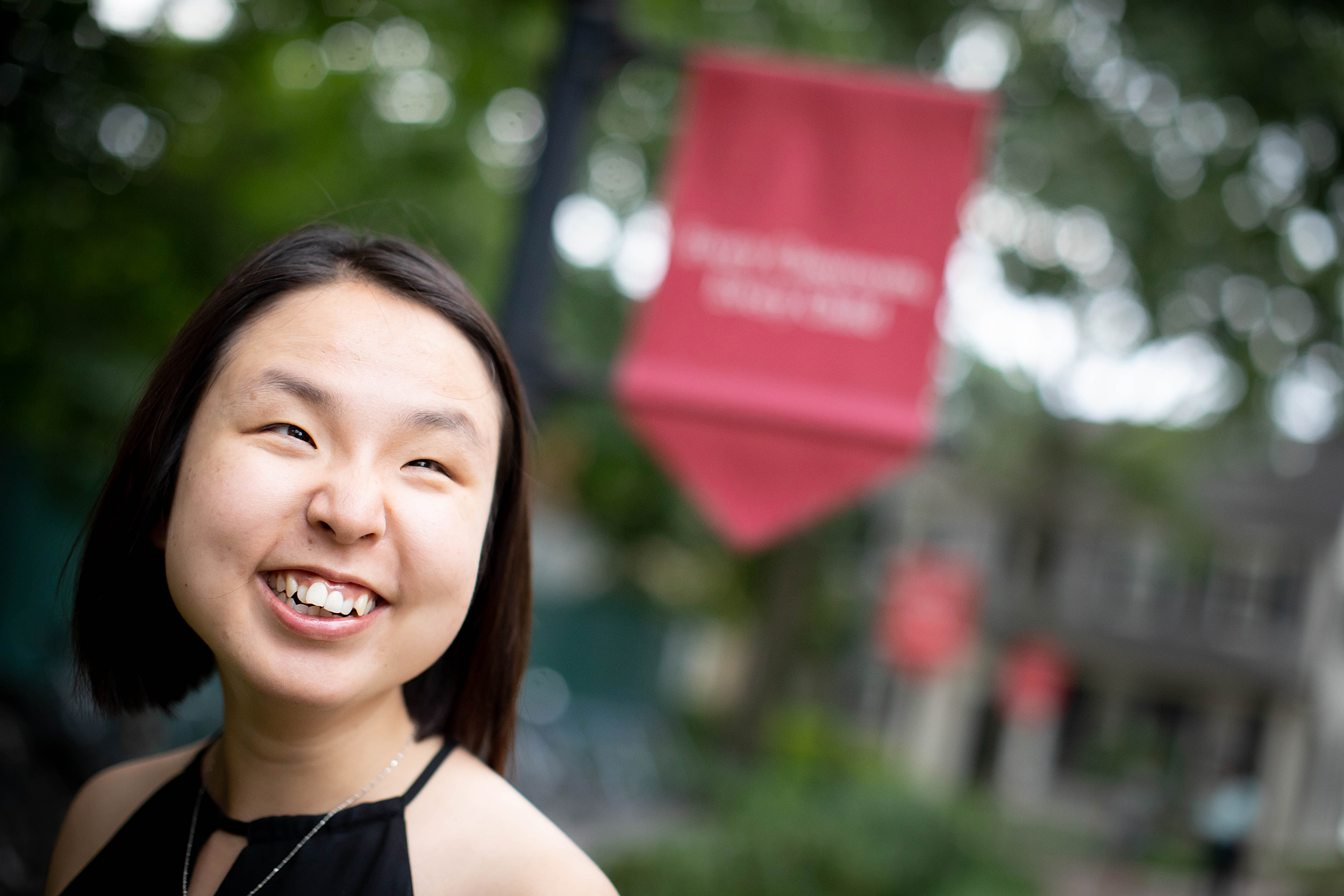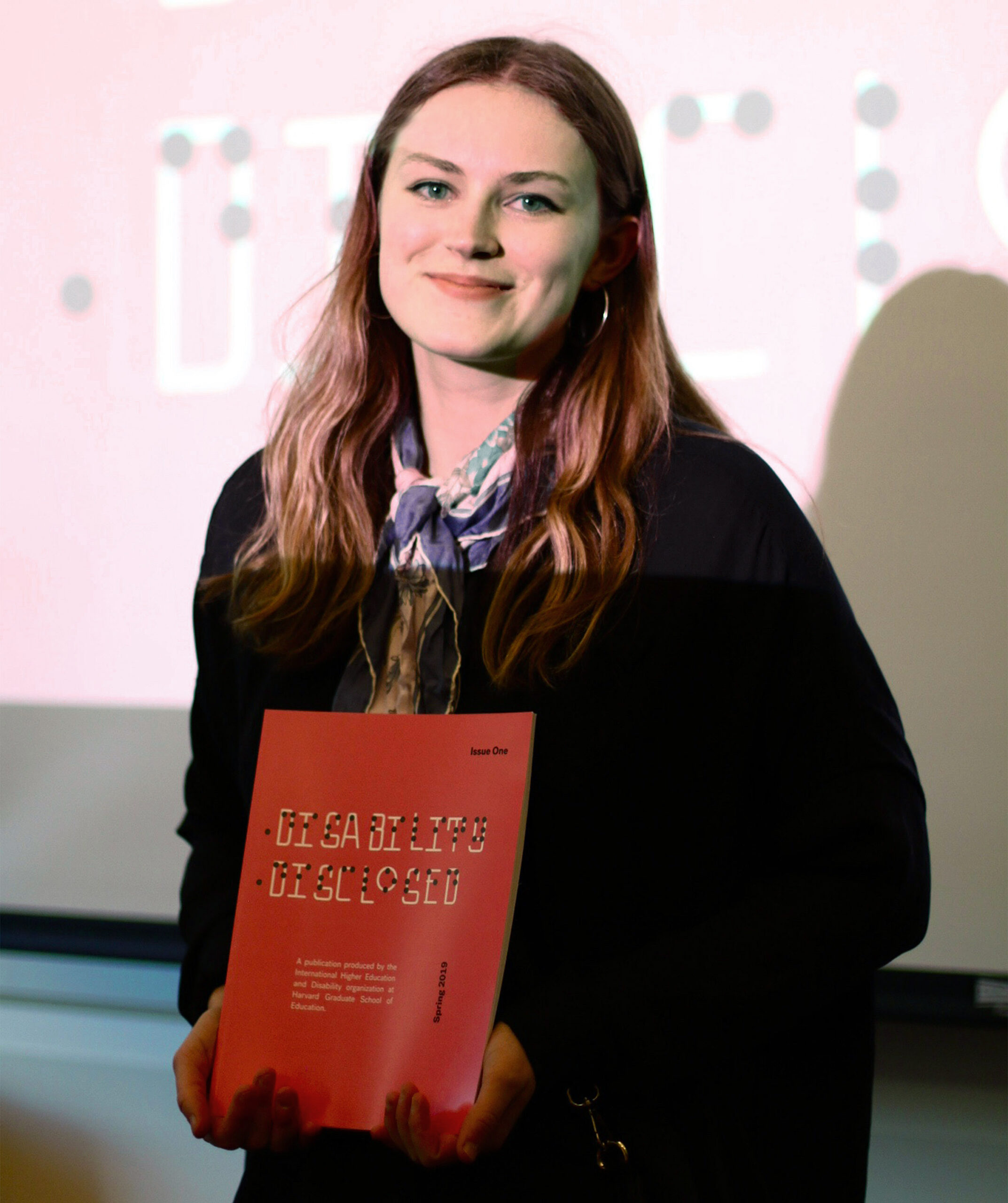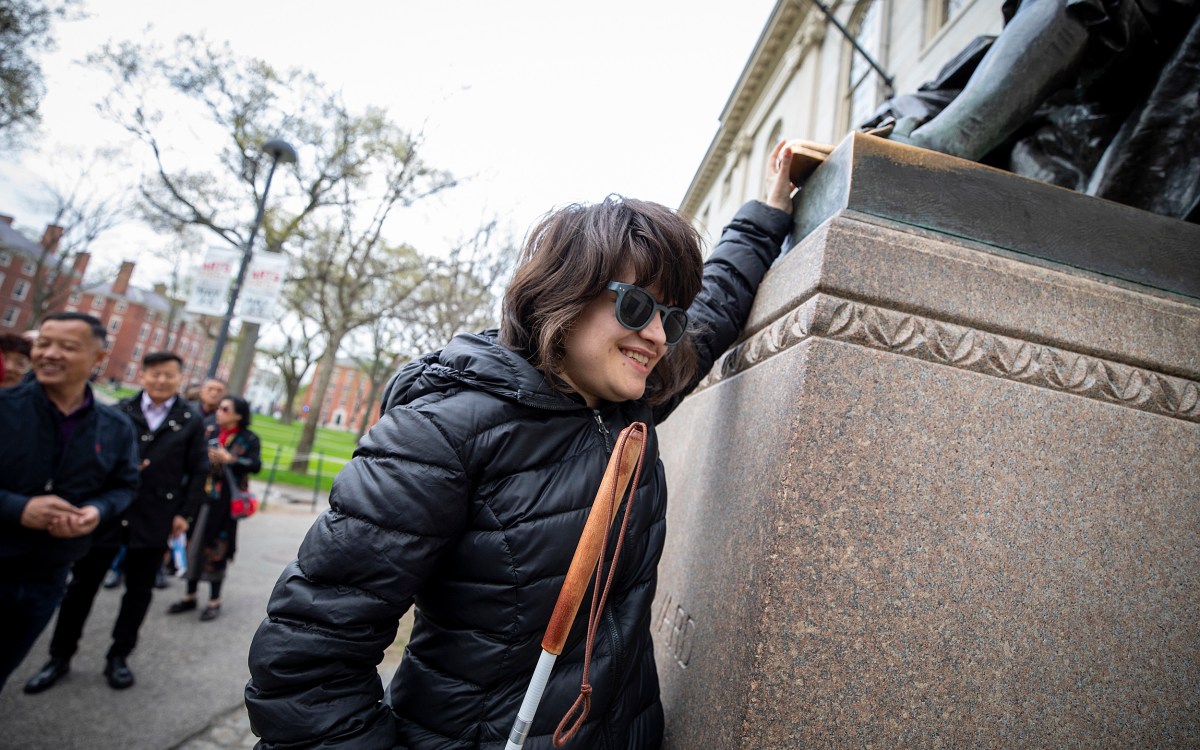
“I think somebody has to come in and say, ‘Look, we are here,'” said Miso Kwak about students with disabilities.
Rose Lincoln/Harvard Staff Photographer
Pulling disabilities out of the shadows
Leaders of student organization launch publication and push to make their issue part of the conversation on diversity and inclusion
Miso Kwak and Nikita Andersson, who bonded over their desire to amplify the voices of students with disabilities, are co-chairs of the International Higher Education and Disabilities organization at the Graduate School of Education (GSE). Kwak, who is blind, pursued a master’s in Education Policy and Management, and Andersson, who is dyslexic, did a master’s in Technology, Innovation and Education. The Gazette spoke with Kwak in Cambridge and Andersson via Skype from London about the challenges that students with disabilities face, the need to talk openly about disability, and their hopes for Disability Disclosed, the student publication they started in May that aims to include disability in the conversation on campus diversity and inclusion. It was launched with the support of the Diversity and Innovation Fund and the Office of Student Affairs at GSE.
Q&A
Miso Kwak and Nikita Andersson
GAZETTE: What prompted you to launch Disability Disclosed?

ANDERSSON: I attended a meeting hosted by the International Higher Education and Disabilities organization at the Ed School because I wanted to join the group. I thought it would be really good if we could get individuals from across the University to write about disability and create a publication that would leave a legacy for our organization and have a lasting impact. We also wanted to inspire future generations of students at Harvard who are interested in disability to continue writing about it and expressing their experiences.
KWAK: When I arrived at HGSE, I knew that the International Higher Education and Disabilities organization existed, but not much information was available on what was done through the group. As you may know, many students at HGSE are in the one-year master’s degree [program]. This means that sustaining student organizations is rather challenging. I initiated the process of reviving the group. When I called the first meeting, a handful of students, including Nikita, showed up. She suggested that we work on a publication, so that became the main project, but we also had other events such as Dining in the Dark, a conversation with Judith Heumann [an international disability-rights activist], and a conversation with former HGSE professor David Rose, known for his Universal Design for Learning guidelines.
GAZETTE: How was your publication received?
KWAK: The launch event was really well attended by students and faculty, not only by the folks at the Ed School, but also from other schools. The director of Harvard Disability Resources came. There was overwhelming support both inside and outside of Harvard. Alumni reached out saying, “When I was going to Harvard, we didn’t have anything like this,” and folks from the D.C. area also emailed us asking about our publication. Now the journal is in the Harvard libraries.
ANDERSSON: We had a number of people reaching out to us from schools and universities across the U.S. saying that this is such a great thing. … [One school] wanted us to send 20 copies, but it’s available online.
GAZETTE: What are your hopes for the next issue?
KWAK: The Office of Student Affairs at HGSE expressed interest in continuing to fund the publication. One of my projects for the summer and fall is to recruit the next cohort of master’s students to take it on. Obviously, we can’t predict how it will be actually carried out given that it is a lot of work. Hopefully, someone will take charge once the school year begins.
ANDERSSON: What I can say is that it was so helpful to take a much broader approach, following the “One Harvard” campaign, to produce this publication rather than keeping it within the Ed School. It was really useful involving students from other Schools, not only using their valuable experiences and input, but also their skills.
GAZETTE: Can you describe the experience of being a student with a disability at Harvard?
KWAK: The experience of students with disabilities differs by School, and that’s because each School operates its own disability service office. For instance, if I were to take a class at the Kennedy School, I would have to go through their disability office. That’s why we really pushed for a “One Harvard” approach. Also, we believe there is value in creating some sort of network of persons with disabilities across Schools.
ANDERSSON: We had students from other Schools coming in and gathering to talk about some of the issues they face and that we all face as a group. It was very useful that … to meet and build a network through this publication.
GAZETTE: What are the most pressing issues students with disabilities face?
ANDERSSON: Disability is incredibly diverse. I’m not sure how I would be able to accurately explain the many different disability issues experienced by students from different Schools.
KWAK: Even just between Nikita and myself, our experiences with disability are different because I’m a blind student and Nikita has more of an invisible disability than I do. That said, I think a common thread of experience for students with disabilities, across disabilities, and across the University, would be the stigma that’s associated with having a disability, especially at a place like Harvard, where intelligence is so valued. There is this idea that people with disabilities have been and continue to be marginalized in many ways, and people don’t even really think about it.
GAZETTE: In your opinion, do the issues of students with disabilities get enough attention?
KWAK: I think somebody has to come in and say, “Look, we are here.” Unless there is staff, faculty, or somebody who is directly affected by disability or experiencing it, I don’t think the population as a whole, or just even the communities that we live in, can talk about disability readily without prompting.
ANDERSSON: Going back to the initial question of why I wanted to do this, it was really just because even if it’s a tiny drop in a huge ocean of silence, we felt we were able to make some students’ voices heard. It would be great if we could have an even bigger publication. It was difficult for us to even make sure that our call for submissions was circulated around enough students. If we have even larger structures in place for things like that, I think we’re going to start to dismantle some of the stigma about disability.
GAZETTE: What can the University do to serve students with disabilities better?
KWAK: It is so obvious, but there are many old buildings at Harvard that are not designed for everyone to access easily, especially students with a mobility disability. There are two other big issues: one is about students with mental health concerns who experience more stigma, and the other is about professors who are not familiar with how to best serve students with disabilities, regardless of the type of disability. Also, unifying the services across Harvard for students with disabilities so that those who want to take classes at other schools don’t have to go through so many steps. That would be much easier. We believe that disability should be celebrated as an asset and a cultural value rather than a deficit and something to be stigmatized, given that Harvard aims to advance diversity, equity, and inclusion.
ANDERSSON: I would really like to see students beyond Harvard doing similar things, not just in American higher education but all over the world, really. As somebody who’s been educated in England, it would be really wonderful to see students in British universities produce publications that can be platforms for the voices of students with disabilities. It’s really important to make all students feel included by raising their voices.
This interview was condensed and edited for length and clarity.






